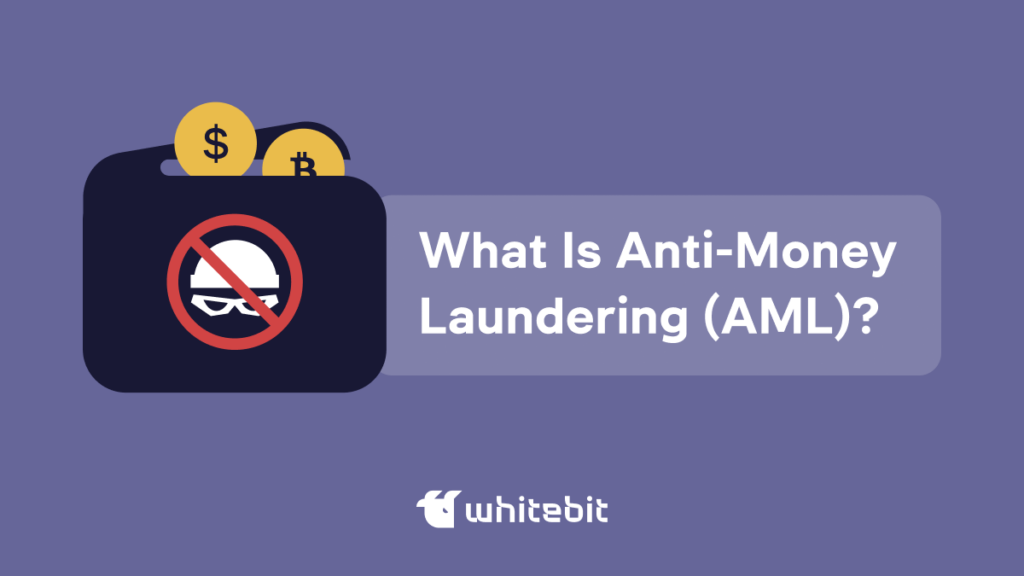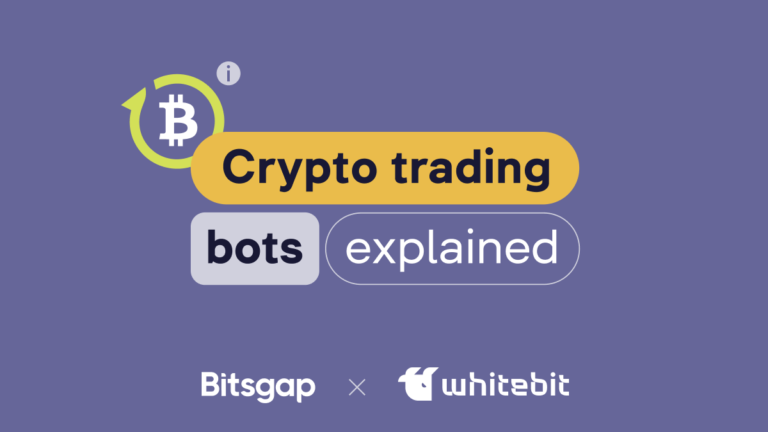What Is Anti-Money Laundering (AML)?

Content
Prevention of money laundering and terrorist financing is one of the essential tasks in finance and banking.
Money laundering is legalizing the proceeds of crime to conceal their origin and make them legal. AML is used to detect and prevent money laundering.
AML is an abbreviation for Anti-Money Laundering. This is a set of measures and procedures designed to prevent the use of the financial system for money laundering. That is the legalization of proceeds from crime. The AML policy aims to prevent criminals from freely disposing of their funds obtained criminally.
In this article, we will take a closer look at what AML is, why it is so essential, and also talk about AML on WhiteBIT, but first, a little history.
History of Anti-Money Laundering
The history of Anti-Money Laundering (AML) began in the 1970s when the first laws pin the United States were passed to combat the use of the financial system for money laundering. The Law on Combating the Use of the Financial System for Money Laundering was passed in 1970. It made it mandatory for banks and other financial institutions to store and report suspicious transactions.
In 1989, the Financial Action Task Force, FATF, was created. This international organization develops standards and recommendations for combating money laundering and the financing of terrorism (Combating the Financing of Terrorism — CFT). FATF has formed 40 recommendations, becoming the international standard in Anti-Money Laundering.
How Anti-Money Laundering Works?
On crypto exchanges, the AML policy usually contains several measures to ensure compliance with international standards in combating money laundering.
The main components of an Anti-Money Laundering policy include the following:
- Client identification (KYC) is the verification of a person signed up on the platform.
- Transaction control helps to detect suspicious activity, such as unreasonable transfers of large amounts of money or repeated transactions.
- The Suspicious Transaction Reporting Policy is a procedure for notifying the appropriate authorities of any suspected activity they have shown.
Crypto exchange personnel should be able to work with AML procedures, particularly how to identify and report suspicious activity.
In many countries, the activity of crypto exchanges is subject to AML regulations by public authorities. This provides additional control and oversight of AML policy enforcement. There is usually industry self-regulation in countries where digital assets are not legal tender.
Why is anti-money laundering important for cryptocurrencies?
AML measures are essential for cryptocurrencies because they help detect and prevent cryptocurrency transactions associated with illicit activities. Cryptocurrencies have become increasingly popular in recent years due to their decentralized nature and the perceived anonymity they offer. However, this anonymity has also made them attractive to criminals for illegal activities, such as money laundering, terrorist financing, and drug trafficking.
AML measures help to ensure that cryptocurrency transactions are conducted transparently and securely. Furthermore, these measures prevent users from receiving the assets used in illegal activities. They also help protect the cryptocurrency market’s integrity by deterring criminals from using cryptocurrencies for illegal purposes.
What is FATF?
FATF is an international organization founded in 1989 within the Organization for Economic Cooperation and Development (OECD) framework. The main goal of the FATF is to combat money laundering and terrorist financing through the development and recommendation of AML/CFT standards.
Who is also involved in Anti-Money Laundering?
In addition to financial institutions and companies subject to AML/CFT regulation, the following are involved in Anti-Money Laundering:
- Committees and organizations like the Financial Action Task Force (FATF) develop international standards and recommendations for preventing money laundering.
- Various law enforcement agencies and institutions include the police, the prosecutor’s office, and the Security Service of Ukraine.
- International organizations and project groups combating money laundering and financing terrorism, such as the Global Coalition to Fight Financial Crime, the Global Forum on Transparency and Exchange of Information for Tax Purposes, etc.
- Payment systems such as Visa and Mastercard with their anti-money laundering measures and AML procedures.
- Enterprises and start-ups provide services for AML transaction monitoring to identify suspicious activity.
How do criminals launder money?
Money laundering involves three stages:
- Placing money in the financial system.
This stage aims to mix dirty money with other funds, making it difficult to trace their origin.
- Moving money across different accounts and transactions.
For example, criminal groups can move money across multiple countries using different banks and other financial institutions. This helps attackers complicate the origin of money.
- Integration of funds into the legal economy.
More often, this is done due to various transactions. This may be the purchase of real estate for dirty money or the transfer of money to a fictitious organization.
Money laundering can have severe consequences for the economy and society because it supports criminal activities and illegal financing of terrorism. Dirty funds can get to you. To avoid this, at WhiteBIT, we check every transaction.
Can money laundering be stopped?
Although it is impossible to stop money laundering completely, it can be significantly reduced by practical measures to combat money laundering (AML) and the financing of terrorism (CFT).
To combat money laundering and terrorist financing, financial institutions must unite and comply with AML/CFT measures. This will become an obstacle to financing criminal groups, reduce the number of suspicious financial transactions and increase the chances of identifying and punishing money launderers.
If most financial institutions act against money laundering, this procedure will become too risky and challenging for attackers.
That is why we adhere to the AML policy and ask users to verify their identity on the exchange before moving on to transactions.
AML regulations and compliance in today’s world
Various regulations and legislation related to AML in today’s world are designed to prevent and detect money laundering and other illicit activities. Here are some of the key regulations and legislation associated with AML:
- Financial Action Task Force (FATF)
It is an intergovernmental organization that sets international standards for AML and counter-terrorist financing (CFT) efforts. Its standards apply to both traditional finance and crypto industries. The FATF‘s recommendations are recognized as the global standard for AML/CFT.
- Bank Secrecy Act (BSA)
The BSA is a U.S. law that requires financial institutions to report suspicious activity to the Financial Crimes Enforcement Network (FinCEN). Cryptocurrency exchanges based in the U.S. are qualified as businesses under FinCEN and BSA regulations. It also mandates the implementation of AML compliance programs and customer identification programs.
- European Union’s Fourth Anti-Money Laundering Directive (4AMLD)
The 4AMLD is a set of regulations that govern AML efforts within the EU. Member states must implement AML policies and procedures, conduct customer due diligence, and establish national registries of beneficial ownership.
- Fifth Anti-Money Laundering Directive (5AMLD)
The 5AMLD expands on the 4AMLD and introduces additional measures to combat money laundering and terrorist financing, including creating a centralized public register of beneficial ownership information. The directive also has regulations for the crypto industry.
These are just a few examples of the regulations and legislation related to AML today. Financial institutions and other businesses must stay up-to-date with AML regulations and compliance requirements to avoid potential penalties and reputational damage.
What is the difference between AML, KYC, CFT, and CDD?
KYC, CFT, and CDD are different aspects of the Anti-Money Laundering (AML) and Counter-Terrorist Financing (CFT) programs commonly used in the banking and financial sectors.
KYC is user verification and confirmation of their identity by requesting personal data. The abbreviation itself comes from the expression Know Your Customer.
CFT is an acronym for Combatting the Financing of Terrorism. This is a program to combat the financing of terrorism. It is focused on preventing and stopping the funding of terrorist organizations by establishing control over financial flows and identifying suspicious transactions.
CDD is short for “Customer Due Diligence,” meaning the customer due diligence process. It is one of the critical elements of the AML (Anti-Money Laundering) system and is covered by many laws and Anti-Money Laundering regulations regarding financial institutions.
What is an AML check on WhiteBIT?
Our exchange does not conduct transactions without checking funds for criminal involvement, and AML verification allows you to avoid links with “dirty” assets.
AML checker verifies all deposits and withdrawals on the exchange. If an address is marked as “high risk,” it means that it could be suspected of due to one of the prohibited actions:
- DarkNet services;
- Gambling;
- Illegal services;
- Malicious software;
- Fraud, and more.
We immediately freeze such operations.
You can also independently check the address with which you plan to interact using the WhiteBIT tool. The fee for using the instrument is 1 USDT. See how to do it:
- In the top menu of the exchange website, open the AML page;
- Choose the cryptocurrency you want to check;
- Enter the address and click Check.
The algorithm will check the address you are interested in. Pay attention to the signals and risk scale. They will show the labels to be wary of and the risk percentage.
By the way, for WBT owners, our exchange offers free daily AML checks.
Conclusion
AML procedures are essential for banks and other financial institutions to prevent the financial system from being used for money laundering and terrorist financing and to reduce risks for financial institutions. Many countries have laws that require AML procedures to be followed and establish liability for non-compliance.
Appropriate implementation of AML procedures is essential in ensuring financial sustainability and combating crime. Therefore, banks and other financial institutions should follow these procedures and cooperate with regulators.
AML and verifying the user’s identity on the exchange help us protect customer data and against dirty funds from getting into them.
FAQ
AML stands for Anti-Money Laundering. AML is a set of measures and procedures to prevent the legalization of proceeds from crime and other financial crimes such as terrorist financing, money laundering, and fraud.
Anti-Money Laundering checks identify and assess the risks associated with using the financial system for money laundering and preventing terrorist financing.
AML checks involve implementing specific procedures to check customers and their financial transactions for compliance with anti-money laundering and anti-terrorist financing legislation.
AML checks are available on WhiteBIT.
AML and CFT are two related concepts aimed at preventing the use of financial systems for the legalization of proceeds from crime, as well as at preventing the financing of terrorism.
The main difference between AML and CFT is that AML covers a broader range of criminal activities that lead to money laundering (e.g., drug trafficking, fraud, corruption, etc.). At the same time, CFT focuses on preventing terrorist financing.









